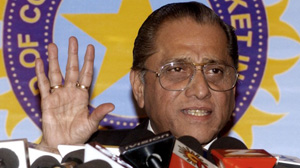School bully mentality in world cricket
View(s):As I remember it, the school bully was always prevalent. The persecutor. The tyrant. The tormentor. The one who used his bigger physical size to intimidate. The one who would coerce, brow-beat, strong-arm and subjugate the weak. Strong words which seemed quite appropriate to the then school environment. Flip this to the corporate world and you begin to see signs of the corporate bully. Throwing muscle behind contracts, manipulating supply chains, forming larger cartels, controlling prices and influencing government policies. The smaller companies, no different from the weaker boys at school, always at the receiving end.

Jagmohan Dalmiya
Take this one step further and more to the specific topic of interest – international sports bodies. How often do we see the powerful playing the role of the high and mighty? Controlling the policies and development of the sport? A regular occurrence, one would say. Why should it be different in cricket? This is what we now believe to be more the norm, than the exception anyway. And so we have seen the three most powerful boards join forces to drive cricket dynamics in their favour, India teaming up with the hitherto dominant boards of England and Australia. And so they will exercise the larger share of control. And so they will enjoy a larger share of revenues. And so the smaller countries have had to toe the line. This inequity is inevitable. To go even one step further, this has indeed been the way of the world.
Of course there are downsides for India here. Not unlike the school bully. The school bully may be feared. But not liked. Anyone having watched an India game in the sub-continent outside of India recently will have an inkling of what is being discussed here. Let us just say that they do not enjoy much favour with the local crowds when they are traveling. Whatever the talent in the Indian dressing room, and whatever the quality of cricket they may bring to the game, the Indian team is finding itself regularly at the receiving end of vociferous and antagonistic crowds – as was very visible in India’s recent tour of Bangladesh. Or the satirical representation of the stalwarts of the Indian team with half shaven heads as appeared in a Bangladeshi newspaper. Was that in bad taste? Absolutely. Over the top? Absolutely. Disrespectful? Absolutely. Acceptable? Why not? India has dished it out to many countries through its corporate advertising. Perhaps executed in better taste, but dished it out nonetheless. So should be its ability to take it bravely, and perhaps even with a sense of humour.
 While the 90’s was the foundation years of India’s cricketing commercial gains, the last decade has seen India build its strength as a cricketing powerhouse, creating along with it a string of extremely rich cricketers. Buoyed further with the success of the IPL over the last eight years, cricket in India, and the money chasing it, has changed like at no time before. Hitherto unknown cricketers have become overnight heroes, earning unheard sums of money. With all corporate money behind a cricket-crazed nation, the shadow of India’s success looms large over the world. Yet, to put it in perspective, in the long history of the game, India’s dominant position as the money-bags of world cricket has been relatively short. India is the newer kid on the block, a sub-continental outsider who has now broken the stranglehold of the more powerful countries. It follows then that the dynamics of the new order cannot be fully formed yet surely, leave alone realized.
While the 90’s was the foundation years of India’s cricketing commercial gains, the last decade has seen India build its strength as a cricketing powerhouse, creating along with it a string of extremely rich cricketers. Buoyed further with the success of the IPL over the last eight years, cricket in India, and the money chasing it, has changed like at no time before. Hitherto unknown cricketers have become overnight heroes, earning unheard sums of money. With all corporate money behind a cricket-crazed nation, the shadow of India’s success looms large over the world. Yet, to put it in perspective, in the long history of the game, India’s dominant position as the money-bags of world cricket has been relatively short. India is the newer kid on the block, a sub-continental outsider who has now broken the stranglehold of the more powerful countries. It follows then that the dynamics of the new order cannot be fully formed yet surely, leave alone realized.
The relevant question is then what India’s role should be? A part of the Big Three Consortium or a champion of the region and the game? A region, with four cricket playing nations and a density of cricketing action like no other, an intensity of fan following like no other. Is the die already cast or does it just need a fresh perspective? Should India’s success be judged by its contribution to the ICC coffers only, or its ability to make the game and the management of it far more inclusive and to grow the game across the cricket playing nations and beyond, and not just its own boundaries.
Mr Jagmohan Dalmiya, the BCCI President, knows and understands cricket administration better than most. He has occupied the highest offices of Indian and international cricket. He has seen India develop from underdogs to a world powerhouse. If there were a man to steer this ship in the right direction, it certainly would be him. Can strong decision-making provide the necessary course correction? Can India take the other cricket playing nations along with it, in its growth trajectory? Idealistic perhaps, but clearly the way forward. Is it time now for the powerful school bully to become the most popular boy in school?


